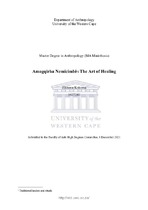| dc.contributor.advisor | Forte, Jung | |
| dc.contributor.author | Kokoma, Zikhona | |
| dc.date.accessioned | 2022-02-14T09:54:05Z | |
| dc.date.available | 2022-02-14T09:54:05Z | |
| dc.date.issued | 2021 | |
| dc.identifier.uri | http://hdl.handle.net/11394/8701 | |
| dc.description | Magister Artium - MA | en_US |
| dc.description.abstract | Amagqirha have been understood solely through the framework of health and illness. Their
image is tainted and they are misrepresented as clad bone throwers and mystical scammers.
There are very few studies that focus on their involvement outside the context of healing.
This study seeks to fill this gap revealing the artistic side of amagqirha. I contend that by
focusing on the ritual space which includes song, dance, fashion, poetry and story telling,
allows us to reveal the aesthetics of ubugqirha, reconstructing the meanings of traditional
healers in contemporary South Africa. Where does knowledge about ritual practice come
from? What role do intergenerational narratives play in the meanings of amagqirha? In what
ways do the rituals of amagqirha are grounded in a disctinctive aesthetics? With the use
informal conversations, close interviews and participating in the rituals of amagqirha in the
townships of Nyanga, Khayelitsha and Langa, this thesis argues that traditional healing is a
complex form of being in the world which draws heavily from intergenerational knowledges.
Furthermore it is artistic in its nature as it includes dance, songs, fashion and poetry. | en_US |
| dc.language.iso | en | en_US |
| dc.publisher | University of Western Cape | en_US |
| dc.subject | Amagqirha (traditional healers) | en_US |
| dc.subject | Ubugqirha (the practice of healing) | en_US |
| dc.subject | Imicimbi (rituals) | en_US |
| dc.subject | Iintsomi (intergenerational stories) | en_US |
| dc.subject | South Africa | en_US |
| dc.title | Amagqirha nemicimbi: The art of healing | en_US |
| dc.rights.holder | University of Western Cape | en_US |

